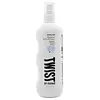What's inside
What's inside
 Key Ingredients
Key Ingredients

 Benefits
Benefits

 Concerns
Concerns

 Ingredients Side-by-side
Ingredients Side-by-side

Water
Skin ConditioningCetearyl Alcohol
EmollientDimethicone
EmollientCeteareth-20
CleansingStearyl Alcohol
EmollientPropylene Glycol Dicaprylate/Dicaprate
EmollientDiazolidinyl Urea
PreservativePropylene Glycol
HumectantPhenyl Trimethicone
Skin ConditioningAminopropyl Dimethicone
Parfum
MaskingDimethiconol
EmollientBehentrimonium Chloride
PreservativeCetrimonium Chloride
AntimicrobialDipropylene Glycol
HumectantQuaternium-91
Cetrimonium Methosulfate
AntimicrobialButylphenyl Methylpropional
PerfumingLactic Acid
BufferingMalic Acid
BufferingLinalool
PerfumingLimonene
PerfumingSodium Hydroxide
BufferingHexyl Cinnamal
PerfumingAloe Barbadensis Leaf Extract
EmollientIodopropynyl Butylcarbamate
PreservativeGeraniol
PerfumingPhenoxyethanol
PreservativeWater, Cetearyl Alcohol, Dimethicone, Ceteareth-20, Stearyl Alcohol, Propylene Glycol Dicaprylate/Dicaprate, Diazolidinyl Urea, Propylene Glycol, Phenyl Trimethicone, Aminopropyl Dimethicone, Parfum, Dimethiconol, Behentrimonium Chloride, Cetrimonium Chloride, Dipropylene Glycol, Quaternium-91, Cetrimonium Methosulfate, Butylphenyl Methylpropional, Lactic Acid, Malic Acid, Linalool, Limonene, Sodium Hydroxide, Hexyl Cinnamal, Aloe Barbadensis Leaf Extract, Iodopropynyl Butylcarbamate, Geraniol, Phenoxyethanol
Water
Skin ConditioningAloe Barbadensis Leaf Juice
Skin ConditioningPhenoxyethanol
PreservativePropanediol
SolventPolysorbate 20
EmulsifyingParfum
MaskingBenzyl Alcohol
PerfumingGlycerin
HumectantPolyquaternium-16
Guar Hydroxypropyltrimonium Chloride
Skin ConditioningCoconut Alkanes
EmollientCoco-Glucoside
CleansingCinnamidopropyltrimonium Chloride
Polyquaternium-44
Cetrimonium Chloride
AntimicrobialAscorbic Acid
AntioxidantCalophyllum Inophyllum Seed Oil
AntimicrobialCaprylic/Capric Glycerides Polyglyceryl-10 Esters
EmollientXylitol
HumectantPanthenol
Skin ConditioningCentella Asiatica Extract
CleansingCoco-Caprylate/Caprate
EmollientHydrolyzed Rice Protein
Skin ConditioningRosa Canina Fruit Extract
AstringentHydrolyzed Quinoa
Skin ConditioningAlthaea Officinalis Root Extract
Skin ConditioningEthylhexylglycerin
Skin ConditioningPotassium Sorbate
PreservativeSodium Benzoate
MaskingBenzyl Salicylate
PerfumingHydroxycitronellal
PerfumingLimonene
PerfumingWater, Aloe Barbadensis Leaf Juice, Phenoxyethanol, Propanediol, Polysorbate 20, Parfum, Benzyl Alcohol, Glycerin, Polyquaternium-16, Guar Hydroxypropyltrimonium Chloride, Coconut Alkanes, Coco-Glucoside, Cinnamidopropyltrimonium Chloride, Polyquaternium-44, Cetrimonium Chloride, Ascorbic Acid, Calophyllum Inophyllum Seed Oil, Caprylic/Capric Glycerides Polyglyceryl-10 Esters, Xylitol, Panthenol, Centella Asiatica Extract, Coco-Caprylate/Caprate, Hydrolyzed Rice Protein, Rosa Canina Fruit Extract, Hydrolyzed Quinoa, Althaea Officinalis Root Extract, Ethylhexylglycerin, Potassium Sorbate, Sodium Benzoate, Benzyl Salicylate, Hydroxycitronellal, Limonene
Ingredients Explained
These ingredients are found in both products.
Ingredients higher up in an ingredient list are typically present in a larger amount.
This ingredient is a preservative, antimicrobial, and emulsifier. It is often used in cosmetics for its ability to cleanse, condition, and reduce static.
Cetrimonium chloride is a quaternary ammonium salt, meaning it has a water-soluble structure.
Limonene is a fragrance that adds scent and taste to a formulation.
It's found in the peel oil of citrus fruits and other plants such as lavender and eucalyptus. The scent of limonene is generally described as "sweet citrus".
Limonene acts as an antioxidant, meaning it helps neutralize free radicals.
When exposed to air, oxidized limonene may sensitize the skin. Because of this, limonene is often avoided by people with sensitive skin.
The term 'fragrance' is not regulated in many countries. In many cases, it is up to the brand to define this term. For instance, many brands choose to label themselves as "fragrance-free" because they are not using synthetic fragrances. However, their products may still contain ingredients such as essential oils that are considered a fragrance.
Learn more about LimoneneParfum is a catch-all term for an ingredient or more that is used to give a scent to products.
Also called "fragrance", this ingredient can be a blend of hundreds of chemicals or plant oils. This means every product with "fragrance" or "parfum" in the ingredients list is a different mixture.
For instance, Habanolide is a proprietary trade name for a specific aroma chemical. When used as a fragrance ingredient in cosmetics, most aroma chemicals fall under the broad labeling category of “FRAGRANCE” or “PARFUM” according to EU and US regulations.
The term 'parfum' or 'fragrance' is not regulated in many countries. In many cases, it is up to the brand to define this term.
For instance, many brands choose to label themselves as "fragrance-free" because they are not using synthetic fragrances. However, their products may still contain ingredients such as essential oils that are considered a fragrance by INCI standards.
One example is Calendula flower extract. Calendula is an essential oil that still imparts a scent or 'fragrance'.
Depending on the blend, the ingredients in the mixture can cause allergies and sensitivities on the skin. Some ingredients that are known EU allergens include linalool and citronellol.
Parfum can also be used to mask or cover an unpleasant scent.
The bottom line is: not all fragrances/parfum/ingredients are created equally. If you are worried about fragrances, we recommend taking a closer look at an ingredient. And of course, we always recommend speaking with a professional.
Learn more about ParfumPhenoxyethanol is a preservative that has germicide, antimicrobial, and aromatic properties. Studies show that phenoxyethanol can prevent microbial growth. By itself, it has a scent that is similar to that of a rose.
It's often used in formulations along with Caprylyl Glycol to preserve the shelf life of products.
Water. It's the most common cosmetic ingredient of all. You'll usually see it at the top of ingredient lists, meaning that it makes up the largest part of the product.
So why is it so popular? Water most often acts as a solvent - this means that it helps dissolve other ingredients into the formulation.
You'll also recognize water as that liquid we all need to stay alive. If you see this, drink a glass of water. Stay hydrated!
Learn more about Water